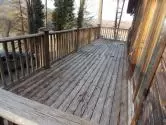Make That an Arts and Crafts Deck

I was standing in line at Home Depot last week, my rolling cart loaded with lumber, screws, a new pair of leather gloves, and topped with my ever-present spiral notebook containing my lists, diagrams, sketches, and things I needed to do.
“My, my,” said a familiar voice behind me, “you certainly have your work cut out for you.”
It was a good friend of mine who works at the Grove Park Inn, and who had helped with last month’s Arts and Crafts Conference.
“This isn’t work,” I explained, leaning against a stack of two-by-fours, “It’s therapy.”
One of the aspects of the philosophy which first drew me to the Arts and Crafts lifestyle was the simple motto: “Head, Heart, and Hand.”
While the benefits of employing our hands may seem obvious to us, when you examine the styles which came before and after Arts and Crafts, those being Victorian, Art Nouveau, Art Deco, and Modernism, none grasped the significance of that simple motto.
Which aptly illustrates the difference between a “style” and a “lifestyle.”

And it wasn’t lost on the early proponents of the Arts and Crafts movement. A young Bill Grueby first packed wet clay into molds at the Low Tile Works. Gus, Albert, and Charles Stickley learned to turn oak spindles on a lathe in their uncle’s rudimentary chair factory, and in turn taught younger brothers Leopold and John how to cut dovetail joints. Elbert Hubbard bound together early copies of his books, and insisted that his son Bert serve an apprenticeship in each Roycroft department, including the leather and furniture shops, before he could eventually direct the Roycroft Campus.
And while my project last week – replacing the rotted boards on a modest, twenty-five-year old deck at one end of our house – certainly did not qualify to stand alongside a Grueby vase, a Stickley sideboard, or a Roycroft copper lamp, it took on a greater significance than it would have had I stood back and watched a crew of professionals do in two days what it took me and my young apprentice a week to accomplish.
Their deck undoubtedly would have been finished faster, with tighter joints and fewer dropped screws, but I would have lost that sense of satisfaction and accomplishment that comes with having made something with your hands.
As well as the added bonus of having taught an eager, but inexperienced young man some basic woodworking and deck-building skills I had learned along the way.
Head, Heart, and Hand.

Until next Monday,
“Those who can, do; those who care, teach.”
Bruce
Top: While cedar is often touted for it’s water-resistance, it has a tendency to rot from the ends, which is what happened to our deck.
Middle: Here’s the new deck, done in tiger-wood, after a morning shower.
